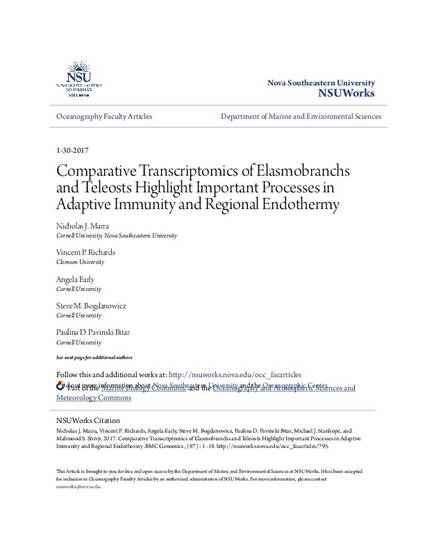
- Regional endothermy,
- Adaptive immunity,
- Gene ontology,
- Positive selection,
- RNA-seq,
- Elasmobranchs
Background: Comparative genomic and/or transcriptomic analyses involving elasmobranchs remain limited, with genome level comparisons of the elasmobranch immune system to that of higher vertebrates, non-existent. This paper reports a comparative RNA-seq analysis of heart tissue from seven species, including four elasmobranchs and three teleosts, focusing on immunity, but concomitantly seeking to identify genetic similarities shared by the two lamnid sharks and the single billfish in our study, which could be linked to convergent evolution of regional endothermy.
Results: Across seven species, we identified an average of 10,877 Swiss-Prot annotated genes from an average of 32,474 open reading frames within each species’ heart transcriptome. About half of these genes were shared between all species while the remainder included functional differences between our groups of interest (elasmobranch vs. teleost and endotherms vs. ectotherms) as revealed by Gene Ontology (GO) and selection analyses. A repeatedly represented functional category, in both the uniquely expressed elasmobranch genes (total of 259) and the elasmobranch GO enrichment results, involved antibody-mediated immunity, either in the recruitment of immune cells (Fc receptors) or in antigen presentation, including such terms as “antigen processing and presentation of exogenous peptide antigen via MHC class II”, and such genes as MHC class II, HLA-DPB1. Molecular adaptation analyses identified three genes in elasmobranchs with a history of positive selection, including legumain (LGMN), a gene with roles in both innate and adaptive immunity including producing antigens for presentation by MHC class II. Comparisons between the endothermic and ectothermic species revealed an enrichment of GO terms associated with cardiac muscle contraction in endotherms, with 19 genes expressed solely in endotherms, several of which have significant roles in lipid and fat metabolism.
Conclusions: This collective comparative evidence provides the first multi-taxa transcriptomic-based perspective on differences between elasmobranchs and teleosts, and suggests various unique features associated with the adaptive immune system of elasmobranchs, pointing in particular to the potential importance of MHC Class II. This in turn suggests that expanded comparative work involving additional tissues, as well as genome sequencing of multiple elasmobranch species would be productive in elucidating the regulatory and genome architectural hallmarks of elasmobranchs.
Available at: http://works.bepress.com/mahmood-shivji/123/

©The Author(s). 2017 Open Access This article is distributed under the terms of the Creative Commons Attribution 4.0 International License (http://creativecommons.org/licenses/by/4.0/), which permits unrestricted use, distribution, and reproduction in any medium, provided you give appropriate credit to the original author(s) and the source, provide a link to the Creative Commons license, and indicate if changes were made. The Creative Commons Public Domain Dedication waiver (http://creativecommons.org/publicdomain/zero/1.0/) applies to the data made available in this article, unless otherwise stated.